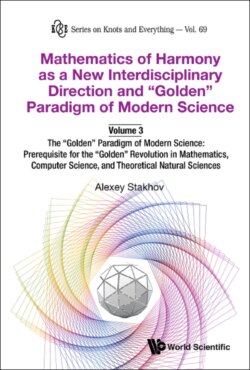Читать книгу Mathematics of Harmony as a New Interdisciplinary Direction and “Golden” Paradigm of Modern Science - Alexey Stakhov - Страница 6
Contents
ОглавлениеPreface to the Three-Volume Book
1.1“Proclus Hypothesis” as a Prerequisite for the “Golden” Revolution in the History of Mathematics
1.2The Paradigm Shift to the “Golden” Elementary Number Theory
1.3Fibonacci Microprocessors as a Prerequisite for the “Golden” Paradigm Shift in Computer Science
2.1The Concept of “Elementary Functions”
2.2Conic Sections and Hyperbola
2.6Millennium Problems in Mathematics and Physics
2.7A New Look at the Binet Formulas
2.8Hyperbolic Fibonacci and Lucas Functions
2.9Recurrent Properties of the Hyperbolic Fibonacci and Lucas Functions
2.10Hyperbolic Properties of the Symmetric Hyperbolic Fibonacci and Lucas Functions
2.11Formulas for Differentiation and Integration
Chapter 3.Applications of the Symmetric Hyperbolic Fibonacci and Lucas Functions
3.1New Geometric Theory of Phyllotaxis (“Bodnar Geometry”)
3.3The Shofar-Like Model of the Universe
Chapter 4.Theory of Fibonacci and Lucas λ-numbers and its Applications
4.1Definition of Fibonacci and Lucas λ-numbers
4.2Representation of the Fibonacci λ-numbers Through Binomial Coefficients
4.3Cassini Formula for the Fibonacci λ-numbers
4.4Metallic Proportions by Vera Spinadel
4.5Representation of the “Metallic Proportions” in Radicals
4.6Representation of the “Metallic Proportions” in the Form of Chain Fraction
4.7Self-similarity Principle and Gazale Formulas
4.8Hyperbolic Fibonacci and Lucas λ-functions
4.9Special Cases of Hyperbolic Fibonacci and Lucas λ-functions
4.10The Most Important Formulas and Identities for the Hyperbolic Fibonacci and Lucas λ-functions
Chapter 5.Hilbert Problems: General Information
5.1A History of the Hilbert Problems
5.3The “Golden” Non-Euclidean Geometry
Chapter 6.Beauty and Aesthetics of Harmony Mathematics
6.1Mathematics: A Loss of Certainty and Authority of Nature
6.2Strategic Mistakes in the Development of Mathematics: The View from the Outside
6.3Beauty and Aesthetics of Harmony Mathematics
6.4Mathematics of Harmony from an Aesthetic Point of View
7.1A Brief History of the Concept of Universe Harmony
7.3Mathematization of Harmony and Harmonization of Mathematics
7.4The Structure of Scientific Revolutions by Thomas Kuhn
